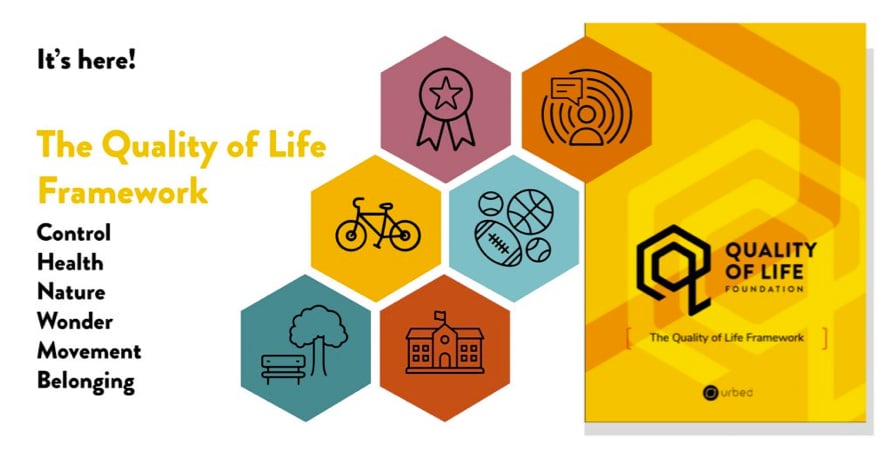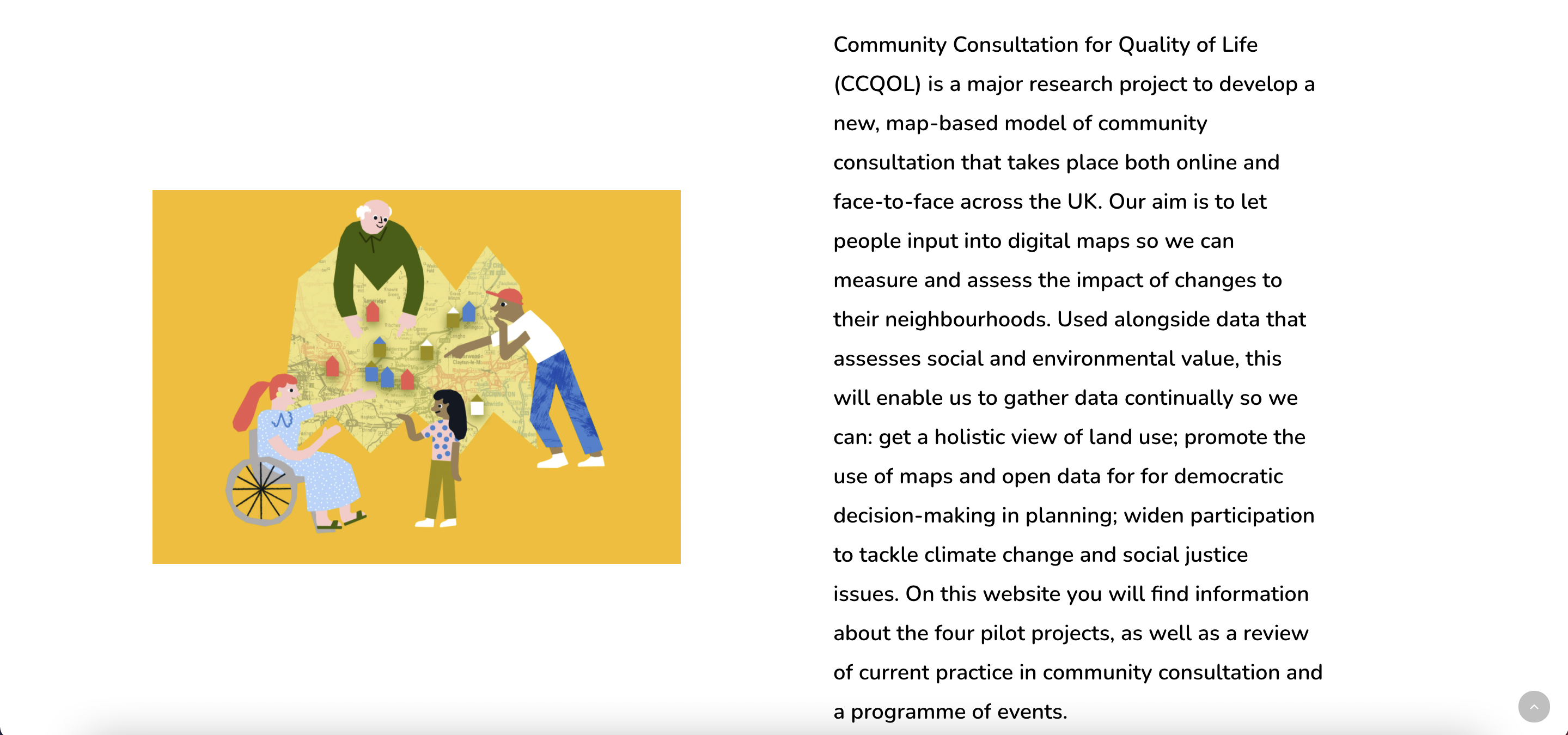Building longer term plans: An interview with the Quality of Life Foundation

By Charlotte Cooper | 18/01/22 15:08
6 min read
How can we bring longer term thinking into our decision making process? This is a question that the Quality of Life Foundation is here to answer. One of our closest partners, we recently sat down with their director Matthew Morgan to discuss how their framework and digital tools can create better tenant relationships all round.
We’ve worked with many Housing Associations over the years and our expert team can show you how to forge stronger relationships with your tenants throughout their tenancy.. Just book a free demo to find out more:
The Quality of Life Foundation (QOLF) was launched with a purpose: to help counter short term thinking in the housing sector and putting the health and wellbeing of people at the centre of new and existing social housing projects. As one of Commonplace’s closest partners, we’ve had the chance to sit down with their director Matthew Morgan and see just how long-term quality of life can be factored into engagements.
Hi Matthew! Tell us about the Quality of Life foundation

In a nutshell, The Quality of Life Foundation aims to make health and wellbeing central to the way that we build and care for our homes and communities. This is all encompassed in the QOLF framework. Carefully designed to help Housing Associations as well as developers in the private sector create better homes and relationships with their tenants, it’s ultimate goal is to bring about a change in the housing industry from a short term mindset to a more long term view that takes into account people’s long term quality of life.
You can read the Quality of Life framework here.
So do you see quality of life as something that can be measured by housing providers?
Definitely, but there’s a certain way to go about it. It’s all about considering people’s lived experiences within their homes and communities as well as their physical, social and psychological wellbeing.
We’re constantly looking at new ways to measure quality of life as it’s something that the whole housing industry is struggling with at the moment. We’re generally averse to putting pounds and pence metrics against people’s lives and prefer to concentrate on their lived experiences. In terms of gathering data, we prefer to speak to people directly and hear about how they feel about where they live as that feels like a key measure in itself. If you know what people need, what their living conditions are and what they need to feel more secure, you can absolutely use that to better their quality of life.
How can we combat short-term thinking in the housing sector?

Now that’s the question. In the industry and in the government, there’s an obsession with numbers: the number of units, profit maximisation or making a dent in the housing crisis. We’d prefer to take a more qualitative view of housing that looks beyond this and sees whether those units add up to a neighbourhood that’s a sustainable place for people to live.
There’s lots of evidence about what makes a good place to live and it’s not always adhered to. We’re just here to remind people that there’s a best way to do things and that tends to be looking into the long-term and what’s going to last. Putting effort into schemes that are socially, economically and environmentally sustainable in the long run for tenants can reap amazing results.
Improving health and wellbeing are central to the quality of life framework. In this regard, has the pandemic impacted the way this framework is implemented?

I think in some ways, the pandemic has actually helped illustrate our cause. It’s made a lot of the general public realise how much their homes and their local areas affect them having now spent so much time confined there. The lockdowns brought to light how strong community spirit can be in times of crisis.
The social inequalities in housing were also made ever more apparent during this time. This included lack of space, upkeep or even access to green spaces. Our framework looks at ways of tackling those inequalities by building in a way that’s equitable and makes the most of any plot or place for the people that will live there.
We’re constantly looking at the framework and refreshing it to make sure it’s relevant to the current times that we’re in - that includes as the pandemic changes around us. We’re at that point where we’ve almost finished establishing the evidence base that we need this framework to find ways to effect change within the industry. We’re doing various projects that will hopefully do just that. We’ll have updates about that later this year!
What’s step one for implementing the QOLF framework?
I’m hoping this interview gives readers an appetite for more, so I’d suggest giving the framework a read and considering all the different aspects of the built environment that affect people. We’ve broken it down into six main categories:
- Control: Do tenants feel like that have a sense of control over the things that happen to their homes?
- Health: Our health is essential to our quality of life. The difference in life expectancy between affluent and deprived areas can be more than ten years
- Nature: We need to green our towns and cities at every level to ensure the wellbeing of the people that live there.
- Wonder: Quality of life also includes a sense of wonder, delight and fun – all of the things that bring us happiness and make us human.
- Movement: Encouraging greener methods of transport like walking, cycling and public transportation not only help the planet, but our quality of life also. It’s about striking the right balance between sustainable transport options while also giving people freedom to travel easily.
- Belonging: As humans, we all want a place to belong. Being part of a community means being of a group and sharing an identity; about trust, cooperation and reciprocity. It’s a huge part of our quality of life.
A lot of the aspects that affect people’s health and wellbeing are social, physical as well as psychological. There are a broad gamut of things that are important to people’s quality of life and it’s crucial to consider as many as possible.
For example, a major problem that can affect people in both rural and urban locations (and something not often considered by Housing Associations - let alone private providers) is loneliness. Nowadays, more people live alone than ever and the way we interact with people has changed. With socialising still heavily based online, physical human connection can be lost and contribute to further loneliness. Checking in with your tenants on issues like this is a simple yet powerful way of, not only showing that you care about their quality of life, but building a stronger relationship with them.
When implementing the framework, how important are digital tools?

Digital tools are crucial for implementing the QOLF framework and they’re very useful for engaging with people in general. The first rule we set, one of the prime drivers for quality of life, is a sense of influence and that only comes through involvement in the process of either creating or caring for a local community. Being involved and engaged is fundamental to that. Obviously digital engagement isn’t the only method of communication, we always prefer to take a hybrid approach where digital is just one part of the engagement process.
You can see this in one of our projects with you: CCQOL (Community Consultation for Quality of Life). This is a major research project with the University of Reading to create a new map-based model of community consultation that takes place both online and face to face across the UK. Our aim is to let people comment on interactive digital maps so we can more easily measure the impact of changes to their neighbourhoods. Used alongside our data that measures social and environmental value, this project will let us harvest data continuously. This blended approach will give us a a holistic view of land use as well as promoting a more democratic decision-making in planning thanks to the project being widely accessible.
Another one of our Commonplace projects, Resident Review, also follows this blended approach. It’s a post-occupancy survey with an online platform, but we also go and speak to people either on the streets or in focus groups so that we can make sure we’re reaching as many people as we can.
What are your hopes for QOLF in 2022?
2022 looks to be a big year for us so we can’t wait to continue on some of our ongoing projects as well as start some new ones. Our main goal is to build on the work we’ve done and to reach more people. We’ve done the research, we’ve created the framework and now it’s all about putting it to work. We want to work with as many different organisations, community groups and Housing Associations as possible to help them to take a more long term view to planning. With every project, we always make sure to emphasize that there are real people whose lives are being affected by the places being built or managed and that their quality of life is crucial for maintaining happy and successful developments.
That was Matthew Morgan of the Quality of Life Foundation! If you’d like to know more about the framework and the foundations work in planning and development, check out their website here.
At Commonplace, we’ve worked with multiple Housing Associations to help build stronger tenant relationships and add more social value to their properties in the long run. Get in touch today and our expert team will be more than happy to show you how our tools can help build a better quality of life for your tenants.
.png)
